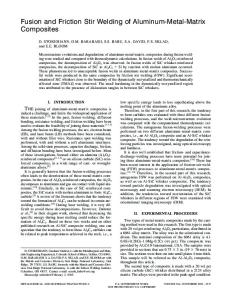Transformation superplasticity of iron and Fe/TiC metal matrix composites
- PDF / 426,960 Bytes
- 11 Pages / 612 x 792 pts (letter) Page_size
- 58 Downloads / 326 Views
I.
INTRODUCTION
THE addition of reinforcing ceramic particulates to iron or steel leads to composites with improved strength, stiffness, and abrasion resistance. Titanium carbide (TiC) is particularly attractive, because of its high hardness and stiffness, its low density, and its chemical stability with iron-based matrices.[1,2] However, the low ductility, low toughness, and high hardness of Fe/TiC composites severely limit traditional forming techniques such as bending, stamping, rolling, forging, or machining. Superplastic forming is, thus, an attractive method for fabricating objects with intricate shapes from simple composite sheets or tubes, which can be produced for Fe/TiC by a near-net-shape technique such as casting[3,4] or powder metallurgy.[5,6] Microstructural superplasticity is, however, very difficult to achieve in Fe/TiC composites, because these materials are too brittle for the thermomechanical treatment necessary to generate a fine grain size, and because ceramic reinforcement can inhibit grain boundary sliding. An alternative superplastic deformation mechanism not necessitating a fine-grained structure is transformation superplasticity, which relies on internal stresses produced by repeated allotropic transformations.[7,8] Plasticity induced by a phase transformation has been extensively studied in unreinforced iron and steels, and can result from two distinct mechanisms: (1) preferential selection by the applied stress of martensite variants with a nonPETER ZWIGL, Graduate Research Assistant, is with the Department of Materials Science and Engineering, Massachusetts Institute of Technology, Cambridge, MA 02139. DAVID C. DUNAND, Associate Professor, formerly with the Department of Materials Science and Engineering, Massachusetts Institute of Technology, is with the Department of Materials Science and Engineering, Northwestern University, Evanston, IL 60208. Manuscript submitted June 10, 1997. METALLURGICAL AND MATERIALS TRANSACTIONS A
zero shear,[9–13] or (2) biasing by the applied stress of isotropic internal stresses due to the volumetric mismatch between allotropic phases during the transformation.[7,8,14] For the latter mechanism, these internal mismatch stresses are generated at each crossing of the allotropic range, so that strain increments can be accumulated after each cycle, eventually resulting in superplastic elongations (.100 pct).[15,16,17] Depending on the material properties and the phase transformation homologous temperature, the internal transformation mismatch stresses can be relaxed by timeindependent plastic deformation or by creep.[14] For the former case, Greenwood and Johnson[14] developed an equation for the uniaxial strain increment Dε, accumulated after a full allotropic transformation, occurring with a superimposed uniaxial biasing tensile stress s. Dε 5
5 6
DV
s
Vs
[1]
Y
where |DV/V | is the volume mismatch between the allotropic phases, and sY is the yield stress of the weaker allotropic phase. Equation [1] is valid for small strains only (Dε ,, |DV/V|) an
Data Loading...











